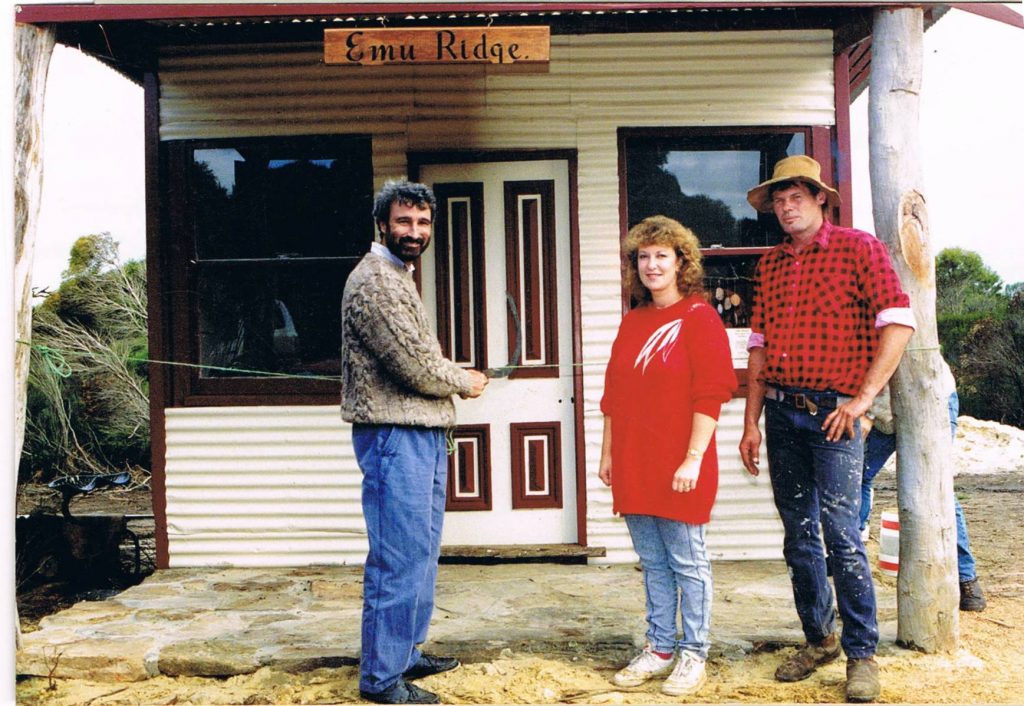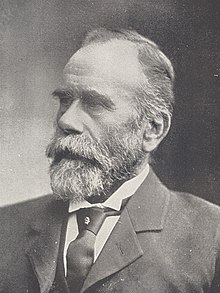No products in the cart.
Kangaroo Island Macgillivray Post Office
04 July 2024

While Burke’s Backyard was filming a documentary at Emu Ridge, Bev and Larry Turner invited Don Burke to officially open the Old MacGillivray Post Office in August 1991. This new location housed their Emu Ridge Souvenir and memorabilia store, a significant upgrade from the small caravan they started with. The image above shows Don cutting a length of binder twine with a leaf sickle to mark the occasion. It was our first television experience, featured on Burke’s Backyard. Prior to this, we had a caravan for our shop, and before that, we had a sign at the distillery directing visitors to our house, where we sold items from a small china cabinet in our lounge room.
This link will take you to our slideshow.

The old Macgillivray Post Office our original shop and our first workshop built from hebel blocks in the background
MacGillivray Post Office Mail
For the information of settlers and others, Mr. H.A. Weber (postmaster at MacGillivray) points out that the mail leaves Kingscote for MacGillivray on Sunday morning at 8 o’clock and returns by 6 p.m. the same day; it reaches MacGillivray at 10:20 a.m. and departs at 4 p.m., delivered by horse.
The Hundred of MacGillivray was named not after a pioneer settler on the island, but in honor of veteran parliamentarian Ivor MacGillivray, one of the first Labor men elected to the State Parliament of South Australia. He represented Port Adelaide in the Assembly from 1893 to 1918, missing only two days of sittings in those 25 years due to Government Business.
Faulding’s purchased the “Emu Ridge” farm, originally “Windy Ridge,” in 1923 and sold it in 1952, the same year the post office closed. Bev spoke to Mrs. Kent, the last postmistress, who mentioned that in the final years of operation, when surveys were being conducted to determine if it was still viable, she would inform the neighborhood to send out letters to prove it was still worth keeping open.
A press report mentioned that the former MacGillivray Post Office building, built in 1909 and now described as an old iron shed, is being used to house a craft and souvenir display to attract tourists and serves as the headquarters of the Emu Ridge Eucalyptus Distillery.
Larry Turner, a shearer by trade and a man of the land, was 31 when he turned back the clock one hundred years on Kangaroo Island to distil eucalyptus oil the way his pioneering forebears did. Larry says, “They were producing eucalyptus oil here in the 1980s; at one stage, there were 48 different stills registered here.” His Emu Ridge property in the Hundred of MacGillivray was once owned by Faulding’s, who produced about 25 tons of oil a year before production ceased. Larry’s talented wife, Bev, makes natural souvenirs, which also attract tourists to the old MacGillivray Post Office.
Fresh growth from the Kangaroo Island Narrow Leaf Mallee is cut, the leaves are boiled in water in a sealed vessel, the oil escapes as vapor, and is finally collected in a system of cooling pipes. The Kangaroo Island eucalyptus oil is unique, with a subtle woody aroma added to the distinctive smell of the oil. It finds a ready market in health and craft shops throughout South Australia, with scores of uses.
Initially, the post office was on the opposite side of the farm it was then owned FH Fauldings. Fauldings sold the property to a farmer called Bill Burns, and then the property was split into 3, and was owned by Lows the first soldier settlers after the war in 1952. It was then moved to the new homestead seen in the picture below. The old photograph below is from Mrs. Kent, the last postmistress to work in this quaint little building. Mrs. Kent said they were going to close the post office in 1950, but they kept it going by telling all the neighbors to send out mail when they were counting letters to see if it was viable to keep open. It eventually closed in 1952. The new homestead was built in the late 50’s that is still standing today and sometime in the early 60s the Post office was moved closer to the house as an office.
The farm passed through the ownership of the Kildea and Wooley families before Larry Turner’s parents purchased Emu Ridge. Larry, who had six sisters, moved into the outhouse, the Post Office to have some space, which was relocated closer to the new homestead built by the Kildea family. Once Larry’s parents retired, he and his wife Bev returned to the farm. The old post office was repurposed for one of Larry’s early business ventures: growing fingerling yabbies, which were sold to mainland breeding farmers. The room was maintained at a constant temperature with an air conditioner to ensure optimal growing conditions. However, without sufficient funding to expand, this project was abandoned, leading Larry to focus on eucalyptus oil production. The old post office was moved to its current location, serving as the original shop for Emu Ridge. The rest is history.
WHERE DID THE NAME MACGILLIVRAY ORIGINATE
MacGillivray in the county of Carnarvon was proclaimed on December 20, 1906. It was named after Ivor MacGillivray MP from Port Adelaide. The MacGillivray Post Office, located 17 km south of Kingscote, opened in April 1909 and closed on November 29, 1952
Ivor MacGillivray
Ivor MacGillivray, MP (1893-1918) was born in Lossiemouth, Scotland in 1840. From the age of 11 he worked on a farm for five shillings a month and lodgings, after four years of this he went on work as a seaman working between the coast of China and Australia, in the Black Sea and Mediterranean. At 19, he left the ship in Melbourne, and spent two years at the Bendigo gold rushes, before leaving for the gold rushes in Otago, New Zealand, where he spent a further twelve years till 1875. He returned to Melbourne, briefly went back to England, and worked as a prospector in Western Australia and South Australia before settling in Adelaide. He worked as a coal lumper at Port Adelaide for 20 years, and was chairman of the Working Men’s Association for 16 years and Trustee for 30 years. He was one of the local leaders of the 1890 Australian maritime dispute.
MacGillivray was elected to the House of Assembly at the 1893 state election. He was expelled from the Labor Party in the 1917. Labor split over his support for conscription in World War I. His son had been killed in the Gallipoli Campaign. MacGillivray recontested Port Adelaide for the splinter National Party, but was defeated by John Stanley Verran.
He retired following the loss of his parliamentary seat in 1918. MacGillivray died at the Adelaide Hospital in 1939, aged 98, following a fall in his home resulting in a broken thigh. He was buried at Cheltenham Cemetery.
Many tributes were paid to his hard work and conscientious efforts during a long term of public Service.
The original Post Office route on Kangaroo Island in the 1800’s and early 1900’s
Some details of early post offices and postmasters for Kangaroo Island are as follows.
Hog Bay opening approved by Colonial Secretary on 30 April 1860. J. Bristow was first postmaster 1861-1870 then J. Adams 1870-1876; W. Sealy 1877 and Thomas Simpson from 1878-1902. J. Bristow and J. Adams are the same person as Mrs Janet Bristow remarried after the death of her first husband
Kingscote opening was approved by Colonial Secretary on 17 April 1862. The office closed in 1866 and reopened in 1871 when A. Reeves was post master from 1871-1876; G. Paris was post master in 1877 and A. Reeves again from 1877-1884 when the post office moved to Queenscliffe (present day the town of Kingscote). I’m hoping State Records can come up with the postmaster/s from 1862 to 1866. The first Post Office in the Nepean Bay area was in Kingscote at what is now Reeves Point in 1862 and it moved to Queenscliffe in 1883 to what is now the town of Kingscote, this is another story.
Cygnet River opened in 1870. Postmaster included G. Woolard 1870-1876 (George?); J. W. Davis 1876; J.N. Daw 1877-1893 and J.W. Daw 1894-1902
Cape Jervis opened in 1873 and closed in 1969. I have a list of seven postmasters between 1873 & 1917
Cape Borda opened in 1876 and closed in 1966. I have a list of 14 ladies and gentlemen who were postmaster between 1876 & 1906.
Eleanor River opened 1 July 1880 and closed 31 January 1883. Postmaster W. Thompson
Cape Willoughby opened in 1880. There were 33 Postmasters mostly being the wife of the head lightkeeper
Wisanger opened 1 December 1882. Postmaster from 1883 to 1902 was Henry Partridge. On 21 July 1904, the post office moved 1½ miles further from Kingscote
Queenscliffe opened 1 September 1883 name of town and post office changed to Kingscote in 1903. Postmaster G.J. Paris 1883-1884; A Munt 1885-1887; R. McClure 1888-1895; H.S. Rumball 1895-1902
Karatta opened 1 November 1884 and closed 1 April 1886. Postmaster H.Y.A. Harper (Hugh?)
Salt Lagoon opened in 1890 and closed in 1922. Post masters included J.H. Trethewey 1891-1900 and Ethel M.D. Trethewey 1900-1902. From 1902 to 1920, George Gobell [senior] ran the Salt Lagoon General & Post Office [Reference Trove: Fire at Salt Lagoon-destruction of Post Office ] On 16th Jan 1911: The Salt Lagoon general store & post office was burnt down. The cause thought to have been from a candle burning left burning [using sealing wax on letters].After 1920 to 1922 The Salt Lagoon General Store and Post Office was run by George Gobell [junior] – Geoffrey Chapman.
Penneshaw name change from Hog Bay w.e.f. 18 October 1904. Postmaster E.C. Trethewey 1910
MacGillivray opened in 1909 and closed in 1952
Emu Bay opened in 1911 and closed in 1955
Source: Walker, Martin, Post, Telegraph & Post Offices of S.A. & N.T. 2004
In 2011, Kangaroo Island celebrated the 175th anniversary of the arrival of European settlers. This milestone was marked with various events, including a re-enactment of the original mail run. The First Settlement in South Australia is commemorated annually on the 27th of July. At Emu Ridge, the re-enactment of the post office route included riders who participated in this historical portrayal. One fun moment was Larry giving a letter to Tom Bruce, who played the role of the mailman.
A team on horseback rode 250 kilometres across the island in a re-enactment of the original postal run. Organiser Roger Borgmeyer said it took a week for the journey that was completed Flagstaff Hill with the raising of the flag. They rode ride in and handed the mail over.
This event highlighted the rich history and heritage of Kangaroo Island, celebrating the early settlers’ contributions and the development of postal services on the island.
EUCALYPTUS HISTORY:
The distillation of Eucalyptus oil from the foliage of the Kl Narrow-leaved Mallee (Eucalyptus cneorifolia) began in the 1890s. Many small ‘rustic’ stills operated on the island, largely to supplement their incomes from other sources, and by the 1920s they were shipping around 80 tons of oil (about 60% pure) to Adelaide per 6annum. Companies such as F.H. Faulding & Company and AM. Bickford & Sons purchased the oil for refining and bottling. Fauldings operated their own distillery, firstly near Retties Bluff and later at Emu Ridge. The industry was based on cutting eucalypt re-growth ‘from the v.::d’ on a three-year cycle; it declined as more land was cleared of its native vegetation cover for grazing and cropping enterprises.
Most of the distilleries were pretty basic and because of this, few of the structures dating from the early era of the industry remain. In 1982, Ted Buick of Kingscote described the operation of his distillery. The eucalypt foliage was compressed into a large metal vat about two metres deep and wide which was a quarter filled with water. The lid of the vat is then securely clamped on and the furnace below lit. To quote Ted Buick, ‘It 5takes about four hours for the water to boil and another four hours for the steam to extract all the oil from the leaves. The oil-laden steam is piped off the top of the vat, passes through two cooling tanks and is finally 2deposited in a holding pit.’ (Geo 1982). This former distillery is on a Burgess family property. The plant was probably last operated by Doug Burgess, grandson of Edward Burgess (1876-1948), son of pioneer settler Alfred Burgess. Edward (Ted) Burgess was born on Kangaroo Island in 1876; he married Wilhelmina Tilka, daughter of Martin Tilka, at the School-room Cygnet River in 1902. Martin Tilka also set us a rose distilling plant but his sons thought there was more money in eucalyptus. Grandfather Burgess set up his first still in 1905, after he had returned to Cassini Bay from the Bendigo goldfields. As the William Holmes Hamilton family partnership at Dover Farm was dissolved in 1904, it seems likely that it was Edward Burgess who purchased the land and built this distillery.
References:
Kangaroo Island Sketchbook, 1975 p.44
Biographical Index of South Australians 1836-1886
Birth, Death and Marriage Records , Genealogy & Heraldry Society of South Australia
Geo Vol. 4 No.3 September-November 1982 pp.29-3065
References Wikipedia










